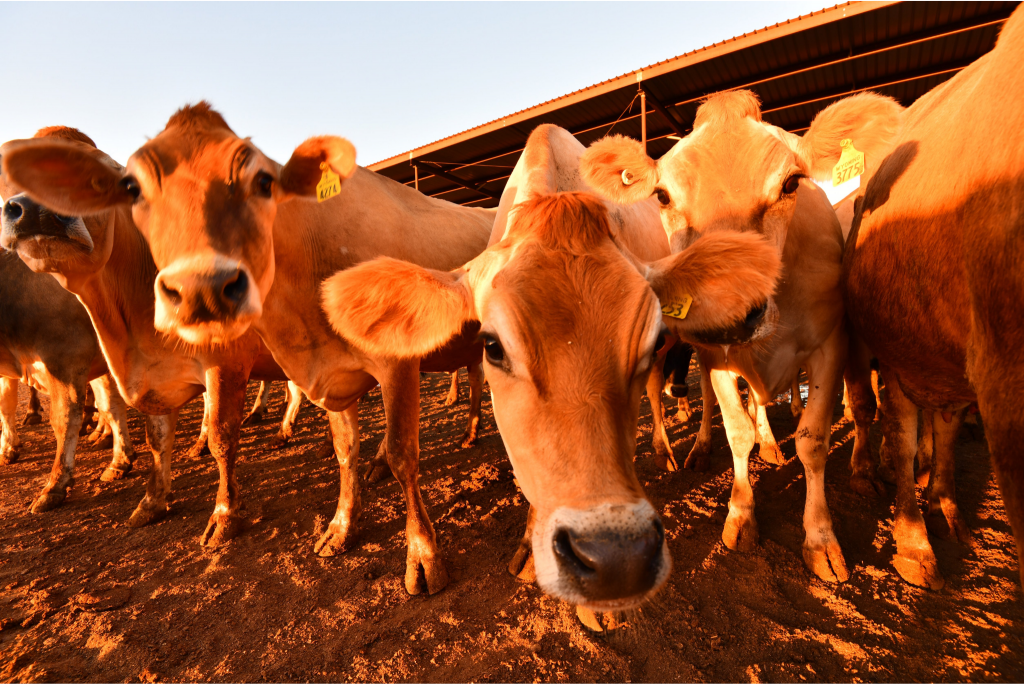Wyoming Dairy Sets Standard for Quality Milk Production
Located in the riverina town of Mayrung, New South Wales, sits the modern 900 acre Wyoming Dairy run by the Steenholdt family.
Bovine health and Jersey cow dairy systems have always been a passion of Mr Steenholdt’s.
“I learned a lot working in the United States for 17 years, particularly when on the intensive dairy farms in New Mexico and Texas. The scale of those farms was just incredible and their dairy systems maximised efficiencies, consistency, quality and high milk yields, forming the basis of our operations in Australia today,” Mr Steenholdt said proudly.
With a masters’ degree in Veterinary Science, Mr Steenholdt and his long-time friend and business partner Eduardo Garbarino co-own and operate their veterinary practice in Texas, as well as the Wyoming Dairy in Mayrung.
Wyoming Dairy, a farm keenly focussed on the future, milks Jersey cows in an intensive dairy system and uses the remaining acreage to grow produce including corn used for silage which is fed as part of the cows’ total mixed ration.
Opening the Dairy five years ago, Mr Steenholdt is passionate about the future of intensive dairy farming, particularly in Australia.
“The intensive dairy system allows us to customise a ration that provides each cow with the nutrients to promote optimum health and milk production,” he said.
Fed on a total mixed ration (TMR) of corn silage, milled barley, canola meal, almond hulls, micro and macro minerals, with a significant percentage of Manildra Stockfeed DDG-S (Dried Distillers Grain Syrup) Wheat Pellets, their Jersey cows thrive, ultimately producing consistent milk yields high in protein and fat.
“The cows love the palatability of the DDG-S Wheat Pellets and when mixed through the ration every ounce of the feed is quickly devoured,” he said.
“Jersey cows are known for their high protein, high fat milk and being able to feed them consistent high-quality feed as opposed to an open grazing system ensures the total milk yield and quality is always above industry benchmarks,” said Mr Steenholdt.
Producing A2 milk from the Jersey cows, Wyoming Dairy sells its entire production to Noumi (formerly Freedom Foods) and ends up in some of the most recognisable dairy brands in Australia.
“Our milk is used as a benchmark for all other milk as the quality is just so consistent,” he said.
A large contributing factor to the success of the Wyoming Dairy is the carefully considered breeding programs and housing of the cows. Using artificial insemination, the Steenholdt’s have transited to a program where they exclusively use sexed semen to determine the gender of calves born, therefore reducing the number of unwanted bull calves.
“It is important to have lactating cows throughout the year, whilst still maintaining a careful ratio of weaning heifer calves and milking cows so we don’t breed more heifers than required to replace the retiring cows.
“By ensuring our younger cows are rearing healthy heifer calves, we have the ability to produce beef-cross wagyu steers from our older cows closer to retirement.
“These beef-cross calves produce top quality beef and are then sold to feedlots whilst the cow will continue to lactate and produce milk at the dairy,” he said.
Mr Steenholdt is enthusiastic about the agronomic opportunities offered in an intensive feedlot diary.
“When you take cattle away from grazing, you can manage the land much more effectively. We can closely monitor their feed and health whilst also reducing the overall output of waste products.
“We are able to produce really high quality crops, growing up to 30 tonnes of dry matter per hectare per annum on the property, all harvested for silage in their daily ration,” he said.
This ‘circle economy’ is one of the many ways Mr Steenholdt sees this intensive diary model as the future of dairy farming, whilst increasing efficiencies across the farm.
With any manure and waste products produced, captured and returned to the crops on the farm to better fertilise the land.
“Not only are we reducing the land used to produce the same, if not more milk, but we are also reducing any damage cows have on the land,” he said.
A rotary dairy, the Wyoming Dairy is still very hands-on with a mix of automation and applied work used every day.
“The fundamentals of the milking process remain the same to grazing dairy systems, and we work hard to ensure the cows are milked all day, every day,” said Mr Steenholdt.
Essential to the dairy’s continued success, calves must grow to almost full size by around 18 months as they prepare to have their first calf.
During this period of incredible growth, the need for sustained nutrition to continue through their life span means a complete diet is crucial.
Head of Manildra Stockfeed, Tim Wirth, can’t speak highly enough of Wyoming Dairy.
“These are some of the healthiest, best kept cows you can find. They are bred well, milked well, and of course fed well,” said Mr Wirth.
“It’s amazing to see a producer with such extensive veterinary experience working at the forefront of intensive dairying and continuing to pioneer dairy production in Australia. It really is going to be the future of the industry,” he said.
“We love Manildra Stockfeed DDG-S Wheat Pellets for Dairy Cows as they offer balanced nutrition whilst still remaining economic. The palatable pellets are a great source of rumen degradable protein, well balanced with starch, sugars, and other carbohydrates – which are perfect for maximising our milk production,” Mr Steenholdt said.
For details on the full range of Manildra Stockfeed products, contact our specialist sales team on 02 4423 8300 or stockfeed@manildra.com.au
